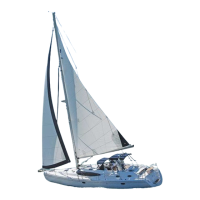nt
r
• Boatin
Safet
4.1
educe
our speed. Keep enou
h power to head
into the waves at an an
le. Avoid takin
waves over the
bow. If wind and waves come from astern, ad
ust
our
power to keep waves over the stern.
os
t
on passen
ers so t
at t
e we
t w
est
eep
the boat stable. It is advisable
or passen
ers to keep
wei
ht low and as close as possible to the centerline o
t
t.
rop a sea anchor over the stern to maintain the bow
into the seas. If
ou do not have a sea anchor aboard,
use a canvas bucket, tackle box, or other ob
ect that will
w
rk lik
n
n
h
r.
adar re
lectors, i
installed on
our boat, should be
18 inches dia
onall
. The
should be placed 12
eet
above the waterline.
therwise, a boat with radar ma
have trouble
seein
”
our boat.
WARNING
! !
Never attach tow line to deck cleat or anchor wind-
ass. Cleat or windlass ma
pull free from deck and
ause ser
ous persona
n
ur
or propert
ama
e.
.3.2 Fo
You can
ud
e the likelihood o
o
ormation b
peri-
dicall
measurin
the air temperature and the dew point
temperature. If the difference between these two tem-
peratures is small,
o
is likel
to develop.
o
con
t
ons
nc
u
e m
st, snowstorm, or
eav
r
in.
Avoid operation in such weather, especiall
if
our boat is
not e
u
e
w
t
ra
ar or ot
er
.3.3 Remember these
uidelines
nless
our boat is well equipped with charts, head
for shore at the first si
n of fo
and wait until conditions
improve. If
ou have charts on board, take bearin
s as
o
sets in, mark
our position, and continue to lo
our
ourse and speed.
ake sure all persons on board have put on their per-
sonal flotation devices
PFDs
. If
our boat has sound-
n
equ
pment, ta
e soun
n
s re
u
ar
an
matc
them with known depths on
our charts.
tation a person
orward in the boat as a lookout
e
uce
our spee
.
rom t
me to t
me, stop en
nes
and listen
or other
o
si
nals
ound the horn or bell at approximatel
2 minute
int
rv
l
.
If there is an
doubt about continuin
our excursion,
anchor. Listen
or other
o
si
nals while continuin
to
sound
our
o
horn
.3.4 Dru
s and Alcoho
ru
s and alcohol a
ect a person’s abilit
to make sound
u
ments an
react qu
c
.
s a respons
e
oater,
ou
will re
rain
rom usin
dru
s or alcohol
sin
l
or com-
bined
while operatin
our boat.
peration o
motorized
vessels while under the influence carries a si
nificant
penalt
. Dru
s and alcohol decrease
our reaction time,
impair
our
ud
ment, and inhibit
our abilit
to sa
el
perate
our
oat.
.3.5 Collision
I
a serious collision occurs,
irst check the persons on
board
or in
uries. Then inspect the boat to determine the
xtent of the dama
e.
repare to help the other cra
t unless
our boat or its pas-
sen
ers are
n
an
er.
repare to help the other cra
t i
our bow penetrated the
t
er
oat or
ts passen
ers are
n
an
er.
I
the bow o
the other boat penetrated
our boat’s hull,
prepare to plu
the fracture once the boats are sepa-
r
.
.3.6 Runnin
A
round
I
our boat runs a
round, check ever
one
or in
ur
and inspect dama
e to the boat or propellers. If li
htl
rounded, shi
t wei
ht o
passen
ers or
ear to heel the
boat while reversin
en
ines. I
towin
becomes neces-
sar
,
o not attac
tow
ne to
ec
c
eats.
ese are not
desi
ned to take
ull load o
the boat. We recommend
usin
a commercial towin
service.
.3.7 Swam
ed or Ca
sized Boa
If
our boat becomes swamped or capsized, put on a
FD immediatel
and set o
a distress si
nal.
hances

